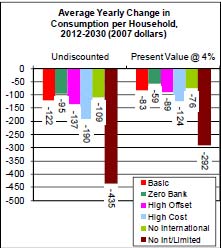Credibility By the Numbers

Many news outlets on Aug. 5 picked up the Department of Energy (DOE) release noting that the third analysis of the American Clean Energy and Security Act of 2009 agreed that the costs to consumers will be low—about 23 cents a day. The statement said: "The EIA analysis projects an increased cost of about $83 (adjusted for inflation) by 2030 — or roughly 23 cents a day." (Is that $83 more dollars or roughly 23 cents a day on top of what I pay now?)
I wanted to verify these numbers so I found the report but could not find 23 cents a day. I enlisted the aid of Jonathan Cogan, the Energy Information Administration's spokesperson, to try to find the modeling information that relates to 23 cents a day. He took me to page 42 of the document, where it states: "In 2020, household consumption losses range from $30 to $362; while in 2030, the range in consumption losses is from $157 to $850 per household."
Consumption losses? Oh, that means consumer spending, Cogan explained. It's all a part of the gross domestic product that was used to develop the numbers. Cogan added that these statistics are just a part of the results. (The bill is complicated, so it makes sense that the economic analysis of it must be, too.)
Still a little hazy, I contacted Alan Beamon, director of the Office of Integrated Analysis and Forecasting's Coal and Electric Power Division. This is the office that developed the report. I asked Beamon about the 23 cents. Here's his response: "The quote you cite … did not come from EIA and is not in our report. That said, I believe that others have derived that number by taking the $83 per year average annual discounted consumption costs per household shown in Figure 34 [on page 43 of the document] in our report for the Basic case and dividing it by 365. I would point out however, that that is only one case in the report, and we would not give it undue weight over the other cases."
Ahhhh, clarity on the 23 cents. Thank you Director Beamon. As Cogan and Beamon told me, there are a range of cases and costs listed in the analysis, making none of them more important than the other — although that's what DOE did. Why did the agency do that? Because it wants Waxman-Markey to pass, I guess. That must be why its government-speak translators didn't spend another 30 minutes on the release to properly characterize the analysis so that stakeholders and legislators could make more informed decisions.
Here's the part of the report that I found more interesting: "Unless substantial progress is made in identifying low- and no-carbon technologies outside of electricity generation, the [bill's] emissions targets for the 2030-to-2050 period are likely to be very challenging as opportunities for further reductions in power sector emissions are exhausted and reductions in other sectors are thought to be more expensive."
What do you think?
Note: The press release from DOE likened the energy cost to consumers to the cost of a postage stamp. What! Who decided to use that? Make up your mind: Does it cost 23 cents or 44 cents, and is that adjusted for inflation?
Posted by L.K. Williams, EPonline on Aug 18, 2009